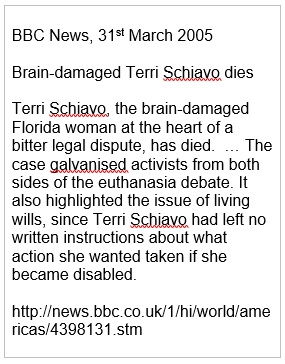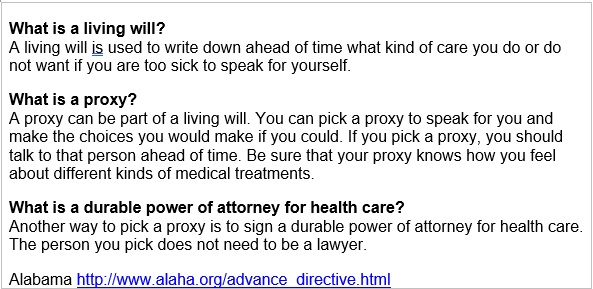Looking for a living will
 Earlier this year, we learned of the bitter legal battles over Terri Schiavo. The case centered on the different interpretations of her wishes by her husband and parents.
Earlier this year, we learned of the bitter legal battles over Terri Schiavo. The case centered on the different interpretations of her wishes by her husband and parents.
Like Terri, I have no “living will.” So I thought it would be a good idea to find out about them, with the usability of the forms in mind.
In 1996, Hoffmann, Zimmerman, and Tompkins did a study of living wills and found that 41 percent of the patients filled in the form inconsistently, giving contradictory instructions, and up to 45 percent filled in the form in a way that did not match their intentions.
So are today’s forms any better? Can we learn some general lessons about usability from them?
Picking some forms
Living wills are legal documents. I wanted a sample of documents that were comparable, so I looked to the US where they are governed by state law but those laws are somewhat similar. I chose six US states: Alabama, Georgia, Maryland, New Mexico, South Carolina, and Wyoming. I thought they would give me a good spread of approaches.
For each state, I hunted for a State Government source for the appropriate forms for creating a living will in that state.
The structure of the task
Creating a living will is a complex task. You need to:
- Understand the various terms used and their meaning in your state. (Comprehension—or “understanding the task”).
- Decide what your wishes are with respect to the health care treatment you receive if you become unable to express those wishes at the time. (Decision—or “finding the answer”).
- Communicate the decisions, preferably by appointing a person whom you trust to act on your behalf and discussing the wishes with them. (Communication—or “discussing the answer”).
- Repeat the process from time to time, so that your expressed decisions continue to align with the current wishes. (Revision—or “keep it up to date”).
These four steps: comprehension, decision, communication, and revision, are implicit in many types of long-term forms tasks such as deciding what to do with your retirement fund, pension, or superannuation. But they are outside of most people’s everyday experience of forms.
Living wills are especially problematic because they require people to make decisions about the unpleasant topic of serious illness.
Comprehension: understanding the task
A quick quiz: What are these, and how are they used?
- Advance directive
- Living will
- Health care proxy
- Durable power of attorney and
- “Do not resuscitate” order?
Not quite sure? Well, try this explanation from South Carolina: “Entry of a Do Not Resuscitate Order is, however, one means of effectuating a patient’s Advance Directive for the withholding of life-sustaining procedures when the conditions set forth in the Advance Directive are met”.
Although the point was not obvious to the South Carolina legislature, I think that as usability professionals we can agree that these legal terms require plain language explanations.
The most confused example I found was from Georgia’s guidance. Someone in Georgia must have realised that their form was tough going, and therefore attempted to write a “friendly” guide to it. Unfortunately, they chose to use first person plural (“we”) rather than writing to the user as “you”. So it contains passages such as this:
“When Does a Living Will Work?
If we are in a Persistent Comatose Condition (Coma);
or
If we are in a Persistent Vegetative State.” (Georgia http://aging.dhr.georgia.gov/DHR-DAS/DHR-DAS_Publications/LivingWill.pdf)
Although “we” seems intended to be approachable, the effect is the opposite—particularly when they give up and mix “you” and “we” in the same sentence:
“As long as your Living Will was signed after 1987, it is good until you revoke it, which means you indicate that we no longer wish to have one.” Georgia http://aging.dhr.georgia.gov/DHR-DAS/DHR-DAS_Publications/LivingWill.pdf
Usability lesson: Do not try to reinvent plain language. Follow accepted principles such as writing to the reader as “you.” (More information on plain language is available at: http://www.plainlanguage.gov)
Decision: finding the answer
Let’s think about an ordinary web transaction—maybe buying a book. Think about the different levels of effort required for finding the answer to these typical questions:
- choice of book
- delivery address
- method of payment.
It’s all somewhat trivial, isn’t it?
Now let’s think about finding an answer to this typical question in a living will form:
“(2) AGENT’S AUTHORITY: My agent is authorized to obtain and review medical records, reports and information about me and to make all health-care decisions for me, including decisions to provide, withhold or withdraw artificial nutrition, hydration and all other forms of health care to keep me alive, except as I state here:” (New Mexico Uniform Health-Care Decisions Act [24-7A-1 to 24-7A-17 NMSA 1978])
To answer this question, a user has to think about complex medical procedures such as artificial nutrition and then think about whether or not they wish to have those procedures in unpleasant medical circumstances. It’s a far more challenging task than the book purchase. My view is that many people will require some help, preferably a structure that takes them through the steps that may be involved in the decision.
All of the forms that I reviewed offer some wording that I interpreted as an attempt to offer some help to users.
I found several examples of mechanical help: instructions that tell you about the mechanics of getting around the form and how to write on it:
“Write your initials next to the statement that says what you want. Don’t use checkmarks or X’s. Then draw lines all the way through other statements that do not say what you want. Please don’t make inconsistent choices. For example, if you initial any or all of items 1, 2, and 3 on Part B of the advance directive, do not initial item 5. Draw lines through it instead. Also, be very careful about item 4. Draw lines through it if you want to make sure that you get pain relief medication.” (Maryland Advance Directives, http://www.oag.state.md.us/Healthpol/adirective.pdf)
Although these instructions are well-intentioned, the user’s best strategy would be to ignore them and to concentrate instead on the underlying, more important task of decision. Therefore, these instructions need to be reworked so that each question is self-contained: the rules about how to place marks and about routing should be right there in the question.
What most people will need is decision help: something that guides them through the thought processes to come to an answer.
Usability lesson: When providing help to users, are you offering mechanical help or decision help? Decision help is more useful (but harder to write).
Communication: telling other people about the decision
Compare this paragraph from the Wyoming Living Will:
“This document has significant medical, legal and possible ethical implications and effects. Before you sign this document, you should become completely familiar with these implications and effects. The operation, effects and implications of this document may be discussed with a physician, a lawyer and a clergyman of your choice.” (Wyoming Living Will, http://www.finance.cch.com/tools/downloads/wyominglivingwill.rtf)
With this extract from Maryland:
“If you decide to make an advance directive, be sure to talk about it with your family and your doctor. The conversation is just as important as the document.” (Maryland Advance Directives,
http://www.oag.state.md.us/Healthpol/adirective.pdf)
I hope you will agree with me that the Maryland one is far better.
But now think about the next step. Imagine opening that conversation with someone in your family. Does that seem hard to do? It certainly does to me.
None of the state forms that I investigated offered any help at this point. Some people may decide that they would prefer to give up on a living will rather than tackle the discussion with the family.
Usability lesson: Sorting out a usability problem at a detailed level may not be enough. We may have to stand back and consider the context to see if there are wider problems.
Revision: keeping it up to date
Consider a Jenny, a 20-year-old who has no impairments and has rarely suffered a day’s illness. Jenny has an active social life, loves to dance, and works out regularly. She thinks about Alice, her 80-year-old grandmother who can barely walk, is going blind, and has hearing problems. Alice rarely leaves the house, is losing her short-term memory, and the highlight of her week is the phone call from her daughter. Jenny looks at Alice and thinks: “I’d rather die than live like that.” Alice does not agree. She has her comfortable home, a dutiful daughter, and her long-term memories are a great companion for her.
If Jenny suffered some devastating disease or accident that parachuted her overnight into the problems of advanced age, then her current “I’d rather die” might still have force. But what if the impairments sneak up on her? Will she still want to die or will she gradually find zest in her life within whatever limits start to apply?
These dilemmas illustrate the importance of keeping an advance directive up-to-date: another aspect that is barely supported by the documents that I reviewed. They mention that you can revoke the document – but give no hint as to why you might want to. Only Maryland offered this sensible advice:
“Once you make an advance directive, it remains in effect unless you revoke it. It does not expire. You should review what you’ve done once in a while. Things might change in your life, or your attitudes might change. You are free to amend or revoke an advance directive at any time. Tell your doctor and anyone else who has a copy of your advance directive if you amend it or revoke it.” (Maryland Advance Directives,
http://www.oag.state.md.us/Healthpol/adirective.pdf)
Usability lesson: Users’ goals change over time. Think about supporting that process of change.
Creating your own advance directive
And a last thought. If the Terry Schiavo case, or anything in this article, has persuaded you to consider making your own advance directive, then you will need to tackle whatever forms are legally required wherever you happen to live. But I also suggest that you investigate:
- The American Bar Association’s free Advance Care Toolkit
- Five Wishes® available for a modest charge from Aging with Dignity
Reference
Hoffmann, D. E., Zimmerman, S. I. and Tompkins, C. J. 1996. “The Dangers of Directives or the False Security of Forms” Journal of Law, Medicine & Ethics 24, no 1, 5-17, the American Society of Law, Medicine & Ethics
This article was first published in User Experience, Volume 4 Issue 3.
#forms #formsthatwork #designtoread


